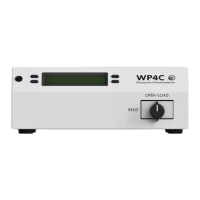3
WP4C
2.2 PREPARING SAMPLES
Proper sample preparation is important to keep the WP4C internal sensors clean and
achieve repeatable results. Carefully prepare and load samples to lengthen the time
between cleanings and help avoid downtime. Be consistent in sample preparation methods
to obtain reproducible results.
Considerations regarding sample temperature are discussed in Section2.3.
NOTE: Calibrate the WP4C (Section4.1) using the same type of sample cup that will be used for subsequent
measurements.
Follow the steps listed below to prepare samples.
1. Choose an appropriate sample cup.
METER recommends using stainless steel cups because stainless steel cups come to
temperature equilibrium with the sample block more quickly, leading to a more accurate
measurement. Only use disposable plastic cups for dry samples.
NOTE: Soil samples can be oven dried directly in the stainless steel cups to determine water content
gravimetrically, which is convenient if generating soil moisture characteristic curves.
2. Place the sample in the sample cup.
a. Completely cover the bottom of the cup, if possible, to provide enough sample to get
an accurate reading.
The WP4C may not be able to accurately measure a sample that does not (or cannot)
cover the bottom of the cup. A larger sample surface area speeds up the reading by
shortening the time needed to reach vapor equilibrium. It also increases instrument
accuracy by providing more stable infrared sample temperature measurements.
b. Do not fill the sample cup more than half full.
Overfilled cups may contaminate the sensors in the chamber.
3. Wipe any excess sample material from the rim of the cup with a clean KIMWIPES
®
tissue.
Material left on the rim or the outside of the cup will prevent a vapor seal with the
sensor block and will contaminate subsequent samples.
4. If a sample cannot be read immediately, put the disposable sample cup lid on the cup to
restrict water transfer.
For longer term storage, seal the lid by placing tape or Parafilm
®
laboratory film
completely around the cup to lid junction.
Thoroughly clean the stainless steel cups using deionized water between uses to prevent
solutes from contaminating subsequent samples and causing artificially negative osmotic
potential.
The WP4C can be used to measure the water potential of leaves and plant material. Refer
to the application note Easy, accurate measurement of leaf water potential using the WP4C
(metergroup.com/environment/articles/measurement-leaf-water-potential-using-wp4c/).

